
Professor Dr. Miethe's Three-Color camera

Professor Dr. Miethe's Dreifarben-Camera is a repeating back three-color camera. The German word dreifarben translates to three-color in English. Because three-color or tri-color cameras make color separations they are also known as color separation cameras. Before color film, color screen plates and similar simple color processes became available, color separations were the only practical means for making color photographs. A repeating back color separation camera takes three successive monochrome photographs of a subject. Each exposure is made through a different colored filter. The filter colors are the additive primaries of red, green and blue. To create the final color image it is necessary to combine the three monochrome separations in some manner. Special viewers were available that optically combined separations to create a virtual color image. It was also possible to project separations using specialized triple-lens projectors. In the past, various assembly printing processes were used, and some of these were capable of making very high quality color prints. Another use for separations was, and still is today, to prepare printing press plates.
Professor Dr. Miethe's Dreifarben-Camera first appeared on the market ca.1903, and it remained in production until the early 1930s. Also known as the Miethe-Bermpohl camera, it was one of the earliest color cameras available for sale. Designed by Dr. Adolf Miethe and built by Wilhelm Bermpohl, the camera was well received among the small cadre of photographers who were adventurous enough to experiment with color photography.
Over the years the Miethe-Bermpohl camera appeared in a variety of sizes and variations. One variation offered a horizontal rather than the more commonplace vertical repeating back. Another variation was in the number of glass plates the camera exposed. The camera on this page exposed one unusually long glass plate; a different version accepted three individual glass plates. Despite these differences in configuration the Miethe-Bermpohl camera retained its basic personality throughout its life. This example appears to be an earlier incarnation. Because of its small niche, it is unlikely that great numbers of Miethe-Bermpohl cameras were produced.

Miethe, Bermpohl and Prokudin-Gorskii
Dr. Miethe was a German
physicist and professor of photochemistry who made numerous important contributions to the field of
photography. To mention only a few, he and
Johannes Gaedicke were co-inventors of magnesium flash powder (1887). Dr. Miethe and T. R.
Dallmeyer simultaneously and independently invented the telephoto lens (1891).
Arthur Traube and Dr. Miethe patented a process of sensitizing silver halides to
the red and orange portion of the spectrum (1902). Their patent was used
by Perutz to manufacture the first panchromatic emulsion. For over six
decades after the invention of photography chemists struggled to create a
photographic emulsion sensitive to the full visible spectrum. This achievement
and further refinement by Dr. Benno Homolka (1907) laid
this essential foundation stone for silver-based color photography.
J. M. Eder described a demonstration by Dr. Miethe in which he projected color photographs that had been taken with his "Miethe-Bermpohl-Kamera". Eder wrote that Dr. Miethe used an ethyl-red plate. This refers to a panchromatic plate that was made using the patented Miethe-Traube ethyl-red isocyanine dye. Quoting Eder:
A. Miethe, in Berlin, used, in 1903, the same idea as Ives and Vidal for the additive color projection of three-color positives, which had been made with the use of his panchromatic ethyl-red plates from nature. The apparatus used by Miethe was constructed by the Goerz Optical Works. This apparatus differed very little from Ives's "triple lantern"; in the Miethe-Goerz apparatus the lanterns were placed one above the other instead of side by side. Miethe inserted red, green, and blue-violet liquid filters in glass cells, which contributed a cooling effect in the path of the rays from the electric projection lamps. With this apparatus colored pictures by additive synthesis were shown on large projection screens at Berlin in 1903. The negatives from nature were made with a camera provided with a long strip of an ethyl-red plate enclosed in a falling plate holder which moved the negatives downward in rapid succession, while a pneumatic shutter made very short exposures possible. This camera ("Miethe-Bermpohl- Kamera") was built by Bermpohl, Berlin, in 1902. (633)
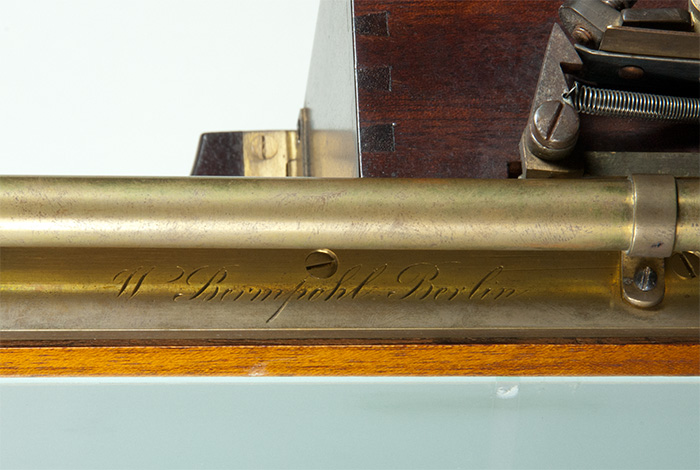
Wilhelm Bermpohl was a German cabinet maker who established a reputation as a master craftsman. According to Keppler, his clients were universities and schools with demanding projects that required precision workmanship. In the late 1800s Professor Miethe conducted experiments into three-color photography. He designed specialized camera equipment for this research, and he needed someone to build it. In 1898 Dr. Miethe asked Wilhelm Bermpohl if he would be willing to join him in his work and construct the needed equipment. Bermpohl accepted, and a mutually beneficial collaboration was born. Their close working relationship allowed Bermpohl to develop invaluable practical experience in camera making. (81)
Professor Dr. Miethe's Dreifarben-Camera was originally designed and built as a research tool. It was also the first camera Wilhelm Bermpohl manufactured for sale to the public. After launching Miethe's Dreifarben-Camera, Bermpohl founded the camera manufacturing firm of Bermpohl and Company in Berlin, Germany. Another of Dr. Miethe's designs led Bermpohl to develop and patent the highly regarded Bermpohl Naturfarbenkamera, a one-shot three-color camera. One-shot color cameras were considered an improvement over repeating back cameras in many respects, but not all. Lower cost, a greater range of camera movements and the ability to accommodate shorter focal length lenses were three advantages in favor of repeating back cameras. However, for professional work the one-shot camera was generally thought to be superior. Soon after the introduction of the Bermpohl Naturfabernkamera, production of the Miethe-Bermpohl repeating back camera ended.

Sergei Mikhailovich Prokudin-Gorskii was a Russian chemist and photographer. In 1889, at the age of 26, he left Russia for a few years and traveled to Germany and France to study and teach abroad. While he was in Germany, Prokudin-Gorskii developed an interest in color photography and it was there that he met Dr. Adolf Miethe. Both men were keenly interested in finding ways to extend the spectral sensitivity of photographic emulsions. A practical application of this knowledge would be to create a panchromatic emulsion, a necessary prerequisite for color photography. While in France, Prokudin-Gorskii worked in the laboratory of the French chemist Dr. Edme-Jules Maumené, who was also conducting research related to color photography.
Prokudin-Gorskii was convinced that as a form of visual communication color photographs would prove to be superior to black and white. Acting on this belief he embarked on an extensive and expensive project to photograph in color, Imperial Russia's land, industry, agriculture, architecture, infrastructure and peoples. Conducted at intervals between 1909 and 1915, the elaborate expeditions were funded by Tsar Nicholas II. From the early days of photography, and throughout the world, a number of large-scale photographic expeditions had been made, but none of this magnitude were previously attempted in color. (However, also in 1909, Albert Kahn began his very large Autochrome project titled The Archive of the Planet ).
The Autochrome, a popular form of color photography was only two years old by the summer of 1909. The number of color photographs taken by all means worldwide in 1909, was an insignificant fraction of the number taken in black and white. With the notable exception of the Ives Kromogram, which was an attempt to popularize a form of color separation photography, color photography prior to the introduction of the Autochrome was primarily experimental. Prokudin-Gorskii's goal of creating a color record of the huge Russian Empire was audacious. Color separation photography was technically challenging but Prokudin-Gorskii was up to the task, having developed the necessary technical and artistic skills. As his photographs reveal, the results were spectacular.
In 1909 Prokudin-Gorskii had two very different means of taking color photographs at his disposal—there was the Autochrome, introduced in 1907, by the Lumière brothers—and color separation photography, the older and technically more difficult means. He chose to use the color separation method.
It is not known what camera Prokudin-Gorskii used, whether it was made in Russia or perhaps an imported model. However, it is known the camera was similar to the Miethe-Bermpohl three-color camera featured on this page. His camera has been described as a small wooden folding camera with a repeating back. Prokudin-Gorskii's negatives, now owned by the U.S. Library of Congress, are long glass plates that measure 9 x 24cm. There are three images per plate, and they're vertically oriented, which indicates the camera used a vertical rather than horizontal repeating back. The plate holders belonging to the camera on this page accept a 9 x 24cm glass plate.
Above is a photograph taken by Prokudin-Gorskii in 1909, and a scan of the glass plate negatives that produced the image. The color photograph was created at the direction of the U.S. Library of Congress. Although the Library of Congress owns the entire known collection of 1,902 Prokudin-Gorskii negatives, no photographic color prints made by Prokudin-Gorskii are known to exist. Prokudin-Gorskii projected his separations with a specially constructed triple-lens magic lantern. It was in this manner that he displayed his color photographs to enraptured audiences. A number of Prokudin-Gorskii's color photographs were, however, published in print form. They appeared in the monthly Russian photography magazine Fotograph-Luibitel (Amateur Photographer), a publication that he edited for a period of four years from 1906. At the time, it was very uncommon for magazines to print color photographs. This act was but another of Prokudin-Gorskii's bold initiatives that stemmed from his conviction that color would and should eventually supersede monochrome photography.
Additional information and the entire collection of Prokudin-Gorskii's photographs can be seen at the Library of Congress website: The Empire That Was Russia.

The Miethe-Bermpohl camera body is made of mahogany and the hardware is brass and steel. The leather bellows is red and black on this example. The lens board is interchangeable. This allows a large variety of lenses with or without shutters to be mounted. Compared to a one-shot camera, a repeating back camera has the advantage that many types of lenses can be used. Due to design constraints, one-shot cameras either did not support interchangeable lenses or they could only accommodate a limited range of focal lengths. Wide-angle lenses can be used on repeating back cameras but not on one-shots. The space taken up by the internal reflectors in one-shot cameras makes for deep camera bodies and this precludes the use of a wide-angle lens. The one notable exception is the very unique Curtis Stellar retrofocus wide-angle lens that appeared on late Curtis one-shot cameras.
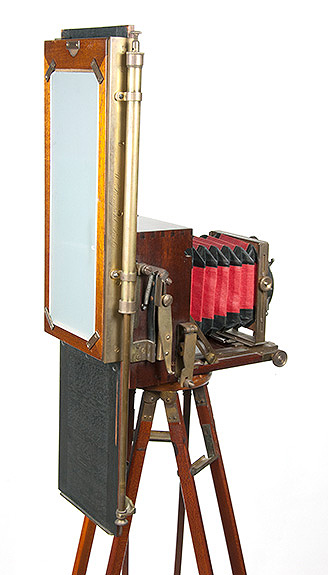
The removable ground glass viewing and focusing screen is shown attached to the repeating back. The red, green and blue filters are not removable so the light from the lens that forms the image on the ground glass will have passed through one of the colored filters. A photographer would normally choose to view through the green filter because the image would be brighter and clearer than when viewed through the red or blue filters. The long sheet of ground glass can be positioned so that the image can be viewed through any of the three filters.
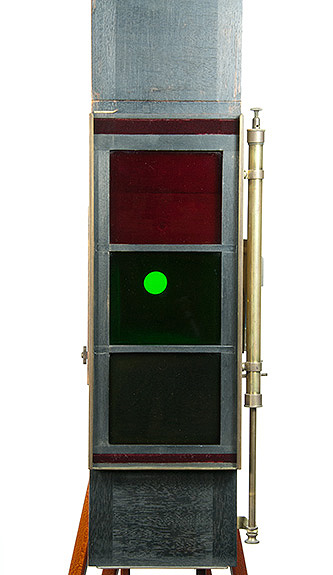
The red, green and blue tri-color filters are mounted in the camera's repeating back. The repeating back is the movable part of the camera. The glass plate holder and filters travel along with the back. To make three successive exposures the back will drop twice, moving one-third of its length each time. The filters travel along with the glass plate, so when a new section of glass plate is in position behind the lens, ready for an exposure, one of the three filters will also be in place between the lens and glass plate.
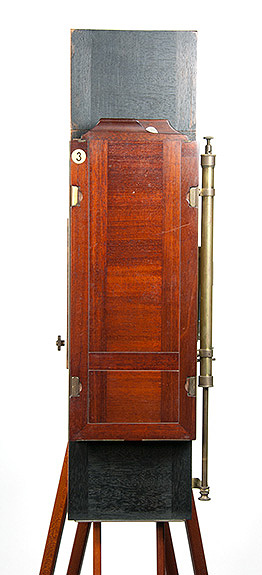
The steps involved in taking a photograph with the Miethe-Bermpohl camera are: With the shutter open, a photographer frames and focuses the subject on the ground glass screen. The next step is to close the shutter or cap the lens. Then the ground glass panel is removed and a plate holder is attached to the back. The back is raised to its highest position, where it is held in place by a spring-loaded latch. It is now time to withdraw the dark slide. The plunger on the cable release is pressed. This is a dual cable release. It is attached to the repeating back latch release and to the shutter. The shutter will fire and then as the plunger is pressed farther, the back latch will release and the back will drop. The long brass pneumatic cylinder that is attached to one side of the camera is called a dash pot. It controls the speed of the moving back. As the back approaches its next position its movement is stopped. It is caught and held by the latch. Beginning with cocking the shutter, these steps are repeated a second and third time.
A self-cocking shutter can be used instead of a set and release type. This would eliminate the time involved in cocking the shutter as well as reduce the risk of moving the camera. In situations requiring long exposures, of one second or longer, a lens cap can be used with a shutterless lens.
A dual cable release is not necessary; the back can be operated with a single cable release or without one. The Miethe-Bermpohl camera is very flexible and it could be configured to the preferences of the photographer and altered as warranted by the subject and conditions. The strength of a repeating back camera is in its adaptability. The Miethe-Bermpohl camera has lens rise-fall and tilt movements, a useful feature that is present on a few but not all one-shot cameras.
With a repeating back camera it is possible to vary the exposure of each shot. This might be done in order to balance the separations (records). Finest quality color prints require optimally balanced separations. With a one-shot camera, the individual records cannot receive different exposures.
Advantages of using a repeating back over a one-shot camera have been mentioned, but there are disadvantages too. An obvious disadvantage is that it's more efficient to make one exposure instead of three, and there will be less chance of making an error. Perhaps the most significant negative aspect of the repeating back camera has to do with the length of time it takes to expose all three records. Any camera movement during or between exposures will ruin a record set because it will not be possible to achieve exact image registration.
The term time parallax refers to a separation in time between exposures. A repeating back camera has time parallax, a one-shot does not. With time parallax, subject movement will cause image differences between the individual negatives. In the final color image differences will appear as color fringing.
I looked through all of Prokudin-Groskii's color images on the Library of Congress website but I was unable to find a good example of color fringing caused by subject movement. Photographs of adults and children alike are very sharp and well registered and yet most of his subjects appear to be relaxed. He must have been able to shoot very quickly and he was obviously very skilled.
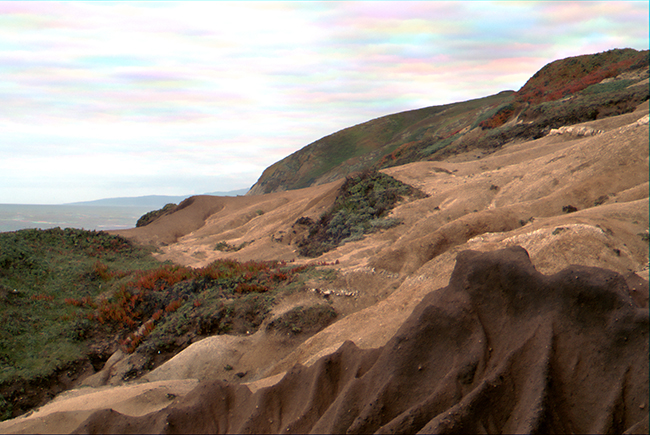
The photo above is an example of time parallax color fringing. I took this photograph with a sliding tri-color filter holder that I made to fit the front of my Nikon camera lens. The clouds should be white and gray but because they moved during the time it took me to slide each filter into position and take a shot, they were recorded out of register. The three monochrome records were assembled in Photoshop to create this full-color image.
The chief strength of the one-shot camera is that it can be used with moving subjects—as long as the exposure is short enough to freeze the movement—so we're really talking about minor movement here. Still, the one-shot was the preferred type of camera to use for subjects that might move during the time it takes to expose three records in a repeating back camera, e.g., people, animals, clouds, water and foliage.
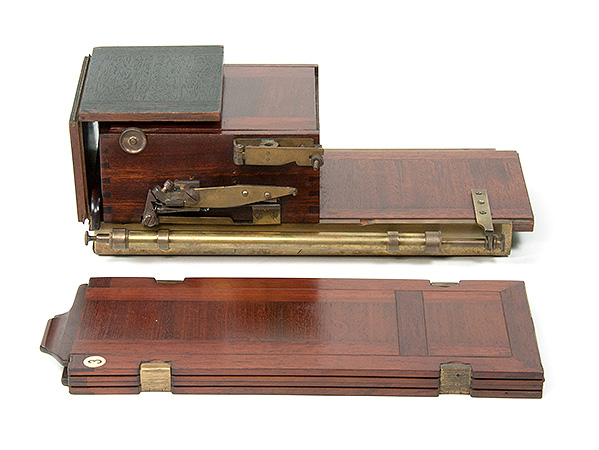
Related Information

|
Page created October 8, 2010;
updated December 20, 2020 |